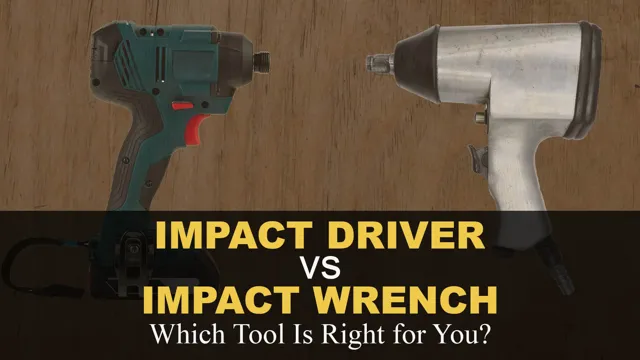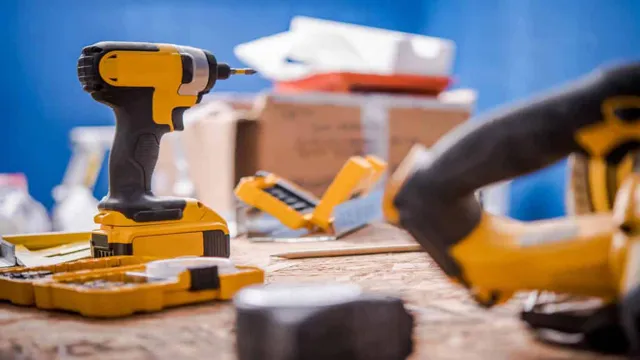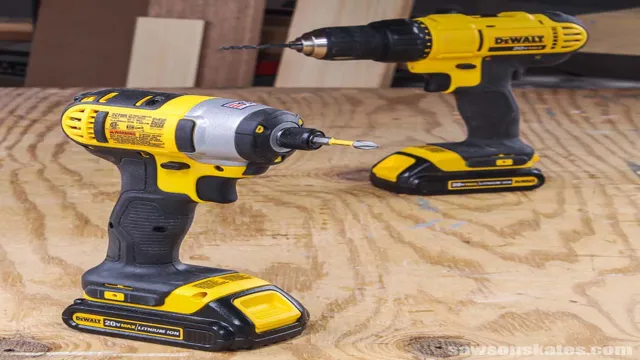What is the Difference Between Hammer Drill and Impact Driver: A Comprehensive Guide

So you’re in the market for a new power tool, but you’re not sure which one to choose – a hammer drill or an impact driver? While both are essential tools for any DIY enthusiast, understanding the difference between the two can make a huge difference in your project’s success. In essence, a hammer drill is more suitable for drilling through tough materials like brick, concrete, or masonry. It accomplishes this by using a pulsing motion that helps to break up the material while simultaneously drilling into it.
On the other hand, an impact driver is ideal for tasks that require high torque, such as screw driving, and can deliver more power with less effort thanks to its rotational motion. So, when should you use a hammer drill and when is an impact driver the preferred option? How do you know which tool will help you tackle your DIY project? We’ll answer all these questions and more in this blog, giving you all the information you need to make an informed decision when it comes to choosing the right power tool for your next DIY job.
What is a Hammer Drill?
If you’re looking to do some DIY home improvements, you might be wondering what the difference is between a hammer drill and an impact driver. While they may look similar, they serve different purposes. A hammer drill is designed for drilling through hard materials like concrete or masonry.
It has a hammering action that helps break up the tough material as it drills, making it easier to make holes. An impact driver, on the other hand, is designed for driving screws and fasteners. It has a strong rotational force that can easily drive screws into tough materials like hardwood or metal.
So, if you’re looking to drill into concrete, you’ll need a hammer drill. But if you’re just looking to put up some shelves or assemble furniture, an impact driver is the better choice. Knowing the difference between the two will help you choose the right tool for the job at hand.
Functionality: How Does a Hammer Drill Work?
A hammer drill is a versatile power tool that combines the functions of a regular drill with those of a hammering tool. This tool is designed with a pulsing action that enables you to drill through more substantial materials such as concrete and masonry with ease. The pulsing mechanism is what sets a hammer drill apart from a standard drill and makes it more effective.
The tool has an additional feature, a “hammer mode,” which causes the drill bit to move up and down while it rotates, crushing the material you are working on as it goes in, making it an excellent tool for demolition work. In contrast to a standard drill, which only rotates the bit, the hammer drill uses a series of interlocking gears to create a “hammer-like” action that allows for more comfortable and quicker drilling of hard surfaces. Whether you need to make tiny holes for mounting frames on a concrete wall or drilling large holes in a brick wall to install electrical wiring, a hammer drill is the right tool for you.
Its unique functions, geared up for solving even the most stubborn drilling issues, make it an essential tool in any DIY enthusiast’s or professional’s toolbox.

Applications: What Projects Are Perfect for Hammer Drills?
A hammer drill is a power tool used to drill holes in materials such as concrete, brick, and stone. It works by delivering rapid, hammering blows as it rotates, making it ideal for drilling into hard materials. What sets hammer drills apart from regular drills is their ability to provide forceful bursts of energy that help break up tough materials.
Hammer drills are perfect for projects that require drilling holes in hard surfaces, such as installing anchors into concrete walls or laying down electrical wiring. So, if you’re planning on tackling a DIY home renovation project that involves drilling into tough materials, a hammer drill is an absolute must-have. With its powerful hammering action, you’ll be able to get the job done quickly and efficiently.
What is an Impact Driver?
If you’re a DIY enthusiast or a professional contractor, you’ve probably heard of both hammer drills and impact drivers. Although these two power tools may seem similar, they are designed for different tasks and provide unique advantages. The main difference between a hammer drill and an impact driver is the type of force they produce.
A hammer drill produces a forward and backward hammering motion that’s ideal for drilling into dense materials like masonry and concrete. On the other hand, an impact driver produces rotational impacts that provide high torque while minimizing user fatigue and preventing stripping of screws and fasteners. In simpler terms, a hammer drill is best suited for drilling holes while an impact driver is ideal for driving in screws and fasteners.
So, the next time you’re working on a DIY project or construction site, remember the difference between these two essential power tools and use them accordingly!
Functionality: How Does an Impact Driver Work?
An impact driver is a powerful tool that is used to fasten screws and bolts quickly and efficiently with minimum effort. It works by using a rotational force called torque combined with concussive blows that enable the device to produce enormous amounts of power in a short amount of time. The impact driver has a hexagonal chuck that accepts a variety of screw bits of different sizes which attach to the drill’s motor.
When you activate the trigger, the motor rotates, and the screw bit turns with it at a high speeds helping in generating torque. When the torque gets to a specific level, that’s when the concussive part of the tool comes into play. The concussive blows, which are up to 50 times more powerful than those of a regular drill or screwdriver, transfer a large amount of energy to the fastener, allowing it to be driven in quickly and efficiently.
The combination of torque and concussive force make an impact driver the ideal tool for heavy-duty projects such as framing, construction, and automotive work. You’ll be amazed at how easy and fast it is to drive even large screws into tough materials like hardwood without breaking a sweat.
Applications: What Projects Are Perfect for Impact Drivers?
What is an Impact Driver? An impact driver is a powerful tool that is specifically designed to make driving screws and loosening bolts easier and more efficient. Unlike a regular drill, an impact driver uses rotational force combined with bursts of concussive force to increase torque and break through tough materials. Impact drivers are perfect for handling large and dense projects, such as building decks, installing fences, and framing houses.
They are also ideal for automotive work and DIY home improvement projects. Impact drivers are versatile and can be fitted with a variety of drill bits and screwdriver heads, giving them the added flexibility to tackle a range of different tasks. Whether you’re a professional contractor or a DIY enthusiast, an impact driver is a must-have tool in your arsenal.
Key Differences Between Hammer Drills and Impact Drivers
When it comes to power tools, hammer drills and impact drivers are two popular options. But what is the difference between a hammer drill and an impact driver? Essentially, a hammer drill is designed for drilling into tough surfaces like concrete and masonry, while an impact driver is geared towards driving screws and lag bolts quickly and easily. Hammer drills have a chuck that moves back and forth to create the hammering action, whereas impact drivers have a mechanism that delivers a series of rapid strikes to the screw or bolt to create torque.
Hammer drills are heavier and more powerful, but impact drivers are lighter and more compact, making them easier to maneuver in tight spaces. Ultimately, the choice between a hammer drill and an impact driver comes down to the type of work you’ll be doing and your personal preferences.
Torque and Power: Comparing Capacities
When it comes to power tools, it’s important to understand the differences between hammer drills and impact drivers. Although they may look similar, they have very different functions. One of the key differences between the two is the amount of torque and power they offer.
Hammer drills are designed to apply force in a consistent, forward motion, making them ideal for drilling into hard materials like concrete or stone. Impact drivers, on the other hand, use a rotational force to apply pressure, making them perfect for driving screws and other fasteners into tough materials. Regardless of which tool you choose, it’s important to understand the specific needs of your project before making a decision.
Consider factors like the type of material you’ll be working with, the size and weight of the tool, and your overall budget. With the right tool for the job, you’ll be able to work more efficiently and effectively, achieving the professional results you need.
Speed and Control: How They Work Together
When it comes to power tools, hammer drills and impact drivers are two of the most popular options on the market. While they may seem similar at first glance, there are some key differences that set them apart. The main difference between a hammer drill and an impact driver is their function.
Hammer drills are designed for drilling into hard surfaces like concrete and masonry, while impact drivers are used for driving screws and nuts. Additionally, impact drivers have a higher torque output, making them more powerful than hammer drills. However, hammer drills offer more control and precision, which is important for certain applications.
Ultimately, the right tool for you will depend on your specific needs and the tasks you will be completing. So, whether you’re a professional contractor or a DIY enthusiast, it’s important to understand the differences between these two tools and choose the one that will work best for you.
Bit Compatibility: What Works with Each Drill Type
When it comes to power tools, the terms “hammer drill” and “impact driver” are often used interchangeably, but they are actually two distinct tools with different purposes. The key difference between hammer drills and impact drivers is the way they apply force to the material being drilled. Hammer drills use a back-and-forth motion that helps to break up tough materials like concrete, while impact drivers use rotational force that is better suited for driving screws or bolts into hard surfaces.
This difference means that while both tools can drill into hard materials, they are better suited for different tasks. If you’re working on a home renovation project that involves a lot of drilling into tough materials like concrete or brick, then a hammer drill would be your best bet. If, on the other hand, you need to drive a lot of screws or bolts into hard surfaces like metal or dense wood, then an impact driver would be the better choice.
Keep in mind that while both tools are versatile, they do require different types of bits, so it’s important to make sure you have the right ones for the job at hand.
Which Tool to Choose for Your Next Project
When it comes to DIY projects, choosing the right tool can make all the difference in the world. Many people wonder: what is the difference between a hammer drill and an impact driver, and which one should they choose for their next project? The answer ultimately depends on the task at hand. Hammer drills are great for drilling into tough materials like concrete, while impact drivers are better for driving screws in quickly and efficiently.
Impact drivers have more torque and are able to handle larger screws than hammer drills, making them ideal for heavy-duty tasks. On the other hand, hammer drills are designed to deliver a powerful blow as they drill, allowing them to shatter tough surfaces with ease. Ultimately, it’s important to consider the specific task you need to complete when choosing between a hammer drill and an impact driver.
Conclusion
In conclusion, choosing between a hammer drill and an impact driver may seem daunting at first, but in reality, it all comes down to the task at hand. If you need precision drilling with minimal vibration, a hammer drill is your go-to tool. However, if you’re looking to drive screws and bolts with ease and speed, an impact driver is the way to go.
Ultimately, having both tools in your arsenal can’t hurt – after all, isn’t it always better to have options? So don’t sweat it, grab your tools and get to work, because with the right tools and a little bit of know-how, anything is possible!”
FAQs
What is a hammer drill used for?
A hammer drill is primarily used for drilling into hard materials like concrete, brick or stone, and has a pulsing mechanism that helps to break up the material.
What is an impact driver used for?
An impact driver is used for driving screws and fasteners, and has a lot of torque to get through tough materials like wood or metal.
Can a hammer drill be used as an impact driver?
No, a hammer drill cannot be used as an impact driver as they have different functions and mechanisms.
What are the main differences between a hammer drill and an impact driver?
The main difference is that a hammer drill is used for drilling into hard materials, and has a pulsing mechanism that helps to break up the material, while an impact driver is used for driving screws and fasteners, and has a lot of torque to get through tough materials like wood or metal.
Which tool is better for DIY projects, a hammer drill or an impact driver?
It depends on the project. If you are drilling into hard materials like concrete or brick, then a hammer drill is the better option. If you are working with wood or metal and need to drive screws and fasteners, then an impact driver is the better choice.
Can an impact driver be used to drill holes?
Yes, an impact driver can be used to drill holes, but it may not be as effective or precise as a drill or hammer drill.
Which tool is more powerful, a hammer drill or an impact driver?
It depends on the specific tool, but in general, a hammer drill has more power for drilling into hard materials, while an impact driver has more torque for driving screws and fasteners.



